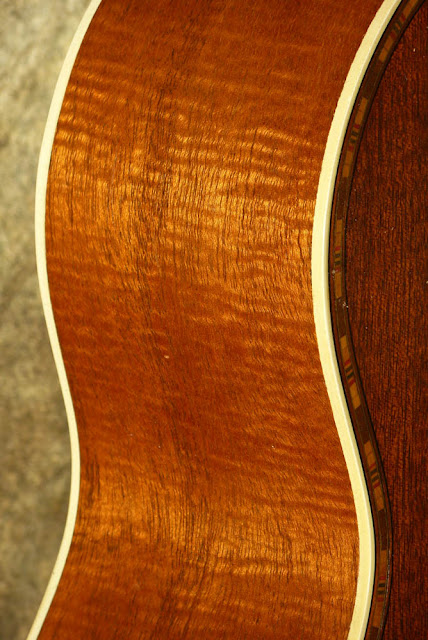1930s Harmony-made Size 5 Mahogany Tenor Guitar
I took the photos for this tenor after work on Saturday and haven't had time to post since! Ah, the busy life. This is a customer's old box and was built by Harmony around 1930. It's solid mahogany throughout, has a Martin-ish "size 5" body and a 12-fret neck. I worked on a similar one of these in recent memory and this one has much the same build. While many players these days are looking to extend tenor guitar range down to "octave mandolin" pitch, most old tenors were voiced for CGDA tuning and so will sound best in that tuning or "Chicago" DGBE tuning. The owner of this guitar is going for that latter choice and I think it's a good one with the direct, woody sound of this one's mahogany top.
My work on this one included a neck reset, fret level/dress, new tuners, replacement bridge, and a bit of cleaning. It plays just about spot-on but the typcally-underbuilt Harmony neck does have a hair of twist I can't rid it of due to the typically-frustrating pearloid fretboard causing a "concave" shape on the fretboard's top (this has to do with the way the wood ages in reaction to the glued pearloid veneer -- most every pearloid-veneer board does this). Still -- 1/16" action height at the 12th fret is as good as it gets, anyhow, so I'm happy with the results.
The mahogany on this tenor is flat-out gorgeous...
...and the creamy-yellow pearloid contrasts with that hog beautifully, too.
The owner has the missing bit of soundhole celluloid binding at home, thankfully.
The nice purfling strips are typical of nicer-quality Harmony gear at this time and this particular variety (which would've had some flashier color when brand new) is seen on many of their products: banjos, mandolins, guitars, ukes, you name it...
The original bridge was split and so I didn't re-use it. I could have made one that was the same shape and size (see, for example, the one on this other tenor), but I wanted to counteract some top deformation caused by overstringing in the past (and also stiffen up the top) so I used a wider, rectangular bridge. This one actually happens to be an old late-30s Harmony guitar bridge with a compensated bone saddle in it and it looked the part -- so I used it! The extra pin holes were filled in with pearl dots.
One has to be very careful with stringing the nicer-grade old Harmony flattops from the 20s-30s. Many are simply under-built. I'm using 30w, 22w, 14, 11 strings on this for DGBE tuning even with the short 21" scale length.
The back and sides (the sides especially) show nice curly and flamed figure.
Inexpensive but effective Kluson-style modern tuners make tuning much easier than the original friction pegs.
Lovely stuff, huh?

















Comments